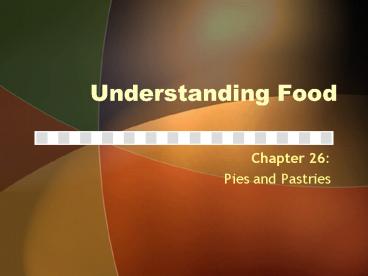Understanding Food - PowerPoint PPT Presentation
1 / 27
Title:
Understanding Food
Description:
Plain pastry: Pastry made for producing pie crusts, quiches, and main-dish pies. ... the filling before adding it into the pie shell. prebake the bottom crust. ... – PowerPoint PPT presentation
Number of Views:100
Avg rating:3.0/5.0
Title: Understanding Food
1
Understanding Food
- Chapter 26
- Pies and Pastries
2
Types of Pastry
- All pastries fall into one of two basic types
- Plain pastry
- Puff pastry
3
(No Transcript)
4
Types of Pastry
- Plain pastry Pastry made for producing pie
crusts, quiches, and main-dish pies. - Puff pastry A delicate pastry that puffs up in
size during baking due to numerous alternating
layers of fat and flour.
5
Types of Pastry
- There are a wide assortment of puff pastry
variations, including - Blitz or quick puff pastry
- Strudel
- French pastries
- Phyllo (fee-low)
- Danish pastries
- Pâte à choux (pot-a-shoe)
6
Preparation of Pastry
- Ingredients of Pastry
- Most pastry flour mixtures usually contain at
least four ingredients - Flour
- Fat
- Liquid
- Salt
7
Preparation of Pastry
- Tenderness
- Gluten-concentration and distribution
- Flakiness
- Fat
- Cold
- Plastic, firm
- Water
- Temperature
8
Preparation of Pastry
9
(No Transcript)
10
Preparation of Pastry
11
Flaky Crust
12
(No Transcript)
13
(No Transcript)
14
(No Transcript)
15
Preparation of Pastry
- F I G U R E 2 6 - 5 Mixing pastry ingredients.
16
(No Transcript)
17
Preparation of Pastry
18
Preparation of Pastry
- Rolling
- Both plain and puff pastry dough must be rolled
- Lamination The arrangement of alternating layers
of fat and flour in rolled pastry dough.
19
Preparation of Pastry
- For plain pastry, the dough is rolled out in a
circle 1 to 2 inches larger than the bottom of
the pan.
20
Preparation of Pastry
- A top crust is placed over the filling using the
wedge procedure, or by lifting the wax paper and
dough together, gently turning it over onto the
filling, and slowly peeling off the wax paper. - Streusel topping
21
(No Transcript)
22
(No Transcript)
23
Preparation of Pastry
- To avoid a soggy bottom crust
- fully thicken the filling before adding it into
the pie shell. - prebake the bottom crust.
- Prepare mealy crust.
24
Preparation of Pastry
- Puff pastry relies on first folding the fat block
and dough together before rolling. - Repeated folding creates numerous layers of
alternating fat and dough. - These numerous folds contribute to the puffing up
that occurs when the steam generated during
baking forces the layers apart.
25
(No Transcript)
26
(No Transcript)
27
(No Transcript)
28
Preparation of Pastry
- Baking
- Whether using a conventional oven, convection
oven, or microwave oven - type of pan
- temperature
- method of testing for doneness
- Blind bake To bake an unfilled pie crust.
29
(No Transcript)
30
Storage of Pastry
- Pastries are best consumed while fresh
- Pastry doughs freeze up to six months.
- Unbaked pies will last about four months in the
freezer, while baked berry pies can be frozen for
six to eight months.































